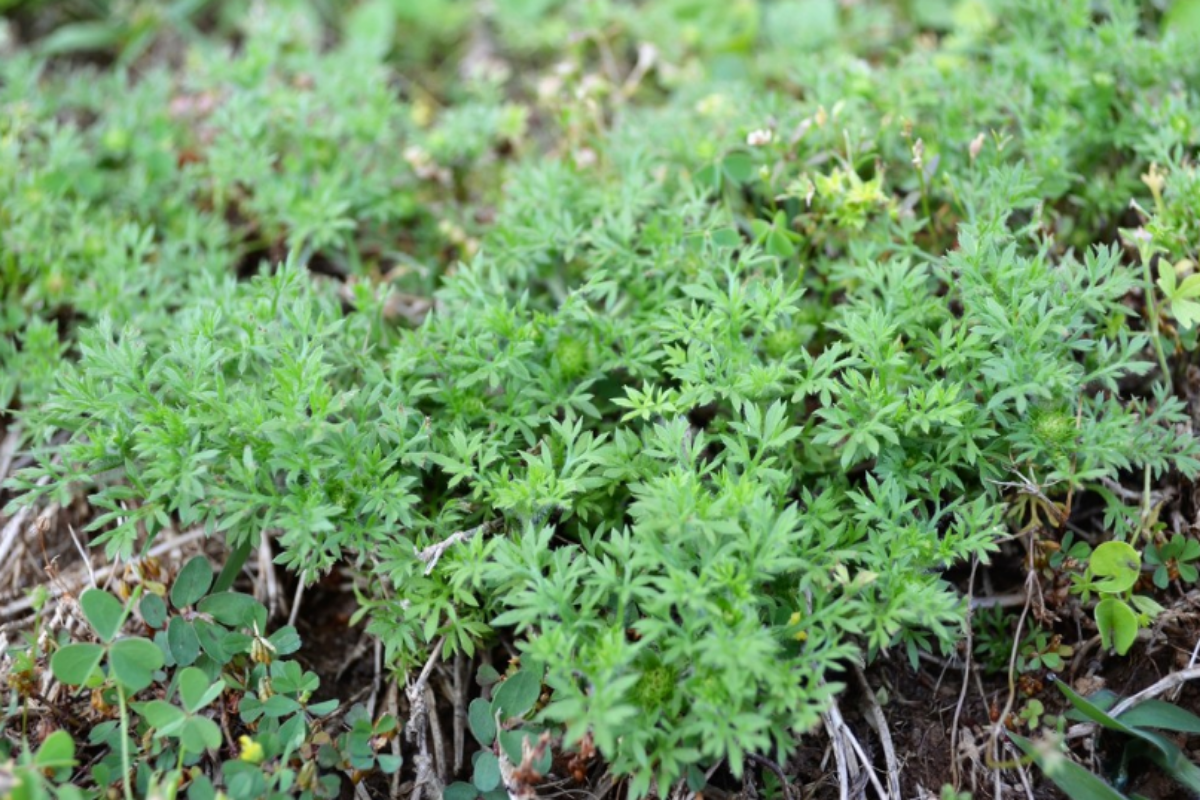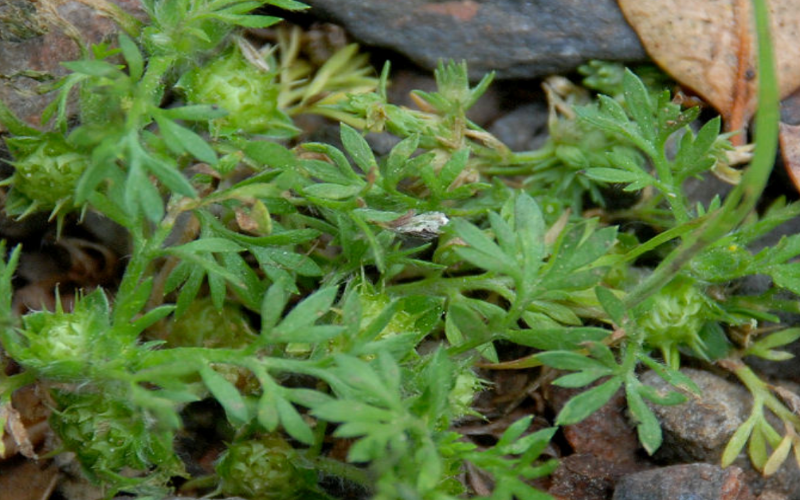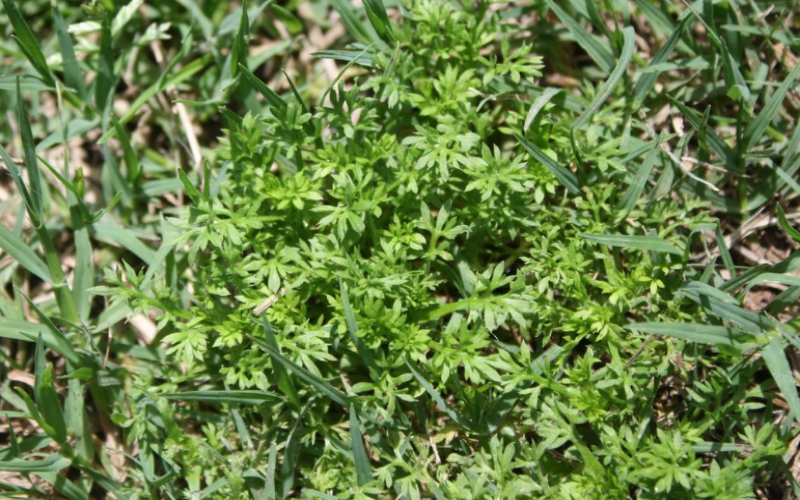Soliva sessilis is a low-growing, broadleaf annual known for its small, sharp-needled seeds. It reproduces by seeds and creeping stems and is typically found in lawns.

It is easily identified by its small feathery leaves resembling parsley, upward-facing seed pods located between branch junctions, and sharp-needled seeds.
Burweed Classification
- Domain: Eukaryota
- Kingdom: Plantae
- Phylum: Spermatophyta
- Subphylum: Angiospermae
- Class: Dicotyledonae
- Order: Asterales
- Family: Asteraceae
- Genus: Soliva
- Species: Soliva sessilis
- Common Names: Common Soliva, Field Soliva, Lawn Burweed, Field Burweed, Carpet Burweed, Bindi Weed, Spurweed, Jo-Jo Weed, and Onehunga Weed.
Nativity and Distribution
Field Burweed is native to South America, from Brazil to Chile. Today, the weed has spread to several places around the world, including:
- United States ( Virginia, North Carolina, California, Florida, Oregon, and Hawaii)
- Canada
- New Zealand
- South Africa
- Australia
- Southern France
Physical Characteristics

- Leaves: Lower rosette leaves and alternately-arranged leaves on stems
- Fruits: Two-lobed, flattened achene about 6mm long
- Stems: Sparsely to very hairy stems with purple spots
- Flowers: Small, inconspicuous, yellow-green disk flowers
- Roots: Fibrous root system
Burweed is a herbaceous broadleaf annual that can spread or grow erect up to 2 inches tall. It is a common lawn weed known for its sharp-pointed seeds.
It is easily identified by its small feathery leaves resembling parsley, upward-facing seed pods located between branch junctions, and sharp-needled seeds.
S. sessilis undergoes two to three leaf growth stages from the seedling to maturity. In the seedling stage, the leaves are oblong-lanceolate.
A basal rosette of petioled dissected leaves then forms, and if the conditions are less favorable, one flower head is formed before cessation. If favorable conditions support growth, secondary stems form with alternate leaves and additional flower heads.
Bindi Weed produces small and inconspicuous, yellow-green flowers about 6mm wide, located on the stem branches or leaf axils.
The seeds are oval, flattened achenes with wings and occasional stiff hairs, about 3-5 mm long.
Reproduction, Dispersal, and Life Cycle
- Life Cycle: Annual
- Seeds: A single plant can produce 100 or more seeds at a time
- Climate: Warm temperate and subtropical climates
- Dispersal: Animals and humans
Soliva sessilis behaves as an annual, thriving in warm, temperate to subtropical climates with mild winters. It reproduces by seed, with a single plant producing 100 seeds or more.
The achenes contain spines that easily attach to the fur of animals and human clothing and shoes. Other items that cause accidental movement of the seeds include backpacks, tent floors, and duffel bags.
The weed typically establishes during fall and winter, especially on stressed or bare cool-season turfgrasses. It can also be found in coastal bluff habitats.
While it mainly propagates by seed, Burweed’s creeping stems can produce shoots that, if left unchecked, will form low, dense patches on lawns.
Similar Plants
- Daucus carota
- Aphanes arvensis
- Matricaria discoidea
- Cotula australis
Uses
Burweed is one of the rare weeds that, despite its far-spreading nature, has no positive uses.
Impact on Farms and Environment

S. sessilis generally occurs in stressed or worn turf and can lead to increased erosion by creating larger bare areas. Additionally, it can lead to rainfall runoff, negatively impacting groundwater supply.
A Burweed infestation adds to the economic cost of turf weed control, including removal and restoration of the affected areas.
An infestation on a golf course impacts the roll of the ball and reduces the aesthetics by leaving brown patches when temperatures are unfavorable. Similarly, it can reduce the value of recreation parks, leading to dwindling revenues.
While it is classified as a turf weed, it has been observed to invade coastal bluff ecosystems in British Columbia, Canada, where it is displacing an endemic species, Limnanthes macounii. This raises concerns for its potential invasiveness in other habitats.
Burweed has a bad reputation for making walking barefoot for humans and pets on turf unbearable. The spine tips often break off on the skin, causing injuries and infections. The painful spines have been associated with causing lameness in dogs.
Control
- Cultural control: Maintaining a healthy turf
- Mechanical control: Hand-pulling and flaming
- Chemical control: Herbicides like isoxaben, dicamba, bentazon, and bromoxynil
Maintaining a healthy turf is the best defense against a Burweed infestation. It is a poor competitor of long, well-fertilized turf.
For already existing infestations, pull young plants from the roots before seeding. Other alternative strategies include pouring hot water and propane torch flaming, especially for areas where herbicides cannot be applied.
The best herbicides to control S. sessilis include isoxaben, dicamba, bentazon, bromofenoxim, and bromoxynil, depending on the timing and turfgrass type.

Lead Editor for Insight Weeds.